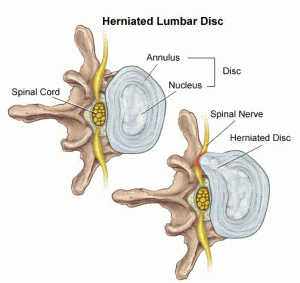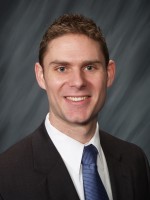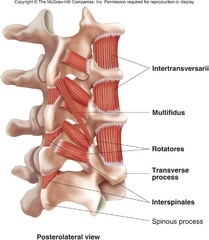Tiger Woods recently went under the knife to fix his acutely painful low back. His official diagnosis was a bulging disc and pinched nerve. Here are the answers to the most common questions I’ve been getting surrounding his injury:
What’s a bulging disc?
Herniated Disc
Your discs are sandwiched between the vertebrae in your spine. Each disc is there to allow for motion and absorbs compressive forces and torque through the spine. There are two main parts to a disc: a sturdy outer-ring ligament called the “annulus”, and a jelly-like substance in the middle called the “nucleus”.
If the outer ligament weakens, the jelly-like substance pushes outwards, and you get a classic “bulging disc”. Even if the condition goes no further than that, it can be incredibly painful because the outer ligament is connected to pain-sensitive nerve endings.
What’s a pinched nerve?
If the bulging disc keeps pushing outward, it will press on a nerve exiting the spinal canal. This results in shooting pain, weakness, numbness, or tingling along the path of the nerve. Perhaps the most well-known type of pinched nerve is called “sciatica”.
How does this relate to the golf swing?
The joints in the low back are perfectly made for flexion and extension (forward and backward bending), but they actually don’t rotate well. In fact, in order for the low back to rotate at all, it needs the help of what’s called “coupled motion”. Coupled motion means that low back rotation must be simultaneously accompanied by side bending. If you don’t side bend, you won’t be able to rotate. You can experience this yourself: go ahead and stand up out of your chair, side bend your torso straight over to the right, stay there, and try rotating your torso in both directions. You’ll find it difficult to turn to the right, but be able to freely turn to the left.
Uncoupling and injury
The nature and mechanics of the golf swing often challenge the limits of this coupled motion. To hit the ball well, golfers often position themselves the edge of unhealthy mechanics. When this happens, the motion shifts from the bony joints in the low back to the discs in the low back. This puts extra stress and load through the disc, and is the functional beginning of the typical bulging disc injury.
The procedure
Tiger underwent a microdiscectomy procedure for his bulging disc and pinched nerve. Essentially his surgeon went in with small (micro-) tools and trimmed off the bulging part of his disc (-discectomy). If all goes well, the disc will heal and the pressure on the nerve will be gone after the procedure. It will take 4-8 weeks for the soft tissues in the disc to fully heal. Typically this takes 3-6 months to rehab and recover from. Given his work ethic, medical staff, and access to cutting-edge rehabilitation, I’m assuming Tiger will be closer to the 3 months.
Do all discs need surgery?
No. Many disc injuries and pinched nerves can be completely fixed with conservative measures. Rehabilitation, McKenzie exercises, core muscle activation, spinal manipulation, traction, and natural anti-inflammatory measures are some of the powerful tools we use at Inertia Health Center to heal these types of injuries.
A smaller six pack
Surgery means that many of the muscles in his spine will be sliced into. His core strength will need to recover and improve. This doesn’t mean he needs a bigger six-pack of abs or that the big muscles in his back need to get stronger. In fact, it’s probably just the opposite. The little muscles around the spine, like the intertransversaii, multifidi, and rotatores will need to be activated again. Additionally, his ability to maintain pressure inside his abdominal cavity during athletic movements will need to improve.
Undoubtedly, Woods’ mechanics need to be tweaked to change the forces through his disc. This may not be a drastic change, but his injury count is stacking up and if he wants to play for another 7-10 years then he’ll need to make the necessary adjustments. All of the iron shots are already being hit to a specific distance so those swings are much less impactful on his discs. Mostly the changes will have to come while he’s swinging the driver. He will have to work hard to respect the natural coupled motion in his back, and avoid excessive extension at impact and follow through.
Prognosis
If Woods rehabs properly, there’s a good chance he returns to form. He can still be the best golfer in the world and an absolute presence in any golf tournament. In the long-term, his body is likely to continue to break down unless he starts to change his mechanics to protect what he has left.
For more information on healing your disc injury or pinched nerve, please give Inertia Health Center a call at 847.496.7175
 Contributing Author
Contributing Author
Dr. Kyle Goerschler, PAK, DNS, TPI
Chiropractic Physician
Owner, Inertia Health Center

Inertia Health Center
1821 Hicks Rd. Suite B
Rolling Meadows, IL 60008
